Bell XV-15
| Bell XV-15 | |
|---|---|
 Bell XV-15 |
|
| Type: | Tilt rotor - VTOL - experimental aircraft |
| Design country: | |
| Manufacturer: | |
| First flight: |
May 3, 1977 |
| Commissioning: |
only used in test series |
| Production time: |
never mass-produced |
| Number of pieces: |
2 |
The Bell XV-15 (designation: Model 301) was an experimental with tilt rotors equipped VTOL - convertible aircraft of the US manufacturer Bell . Bell Helicopter developed the Model 301 based on the Model 300 for test purposes.
functionality
Convertible planes take off vertically with their rotors pointing upwards like a helicopter . To take up horizontal flight, the rotors are then swiveled forward by 90 °. The transition from hover to level flight is called transition . In level flight, the wings provide lift , while the tilt rotors only generate propulsion. The XV-15 uses two turboprop engines for propulsion , which are mounted in pivoting nacelles on the outside of the wing ends and drive the propellers directly.
development
Since the tests with the Bell XV-3 in the 1950s and 1960s were at least partially successful, a new test aircraft called the "Model 300" was built at the end of the 1960s. Based on this, the "Model 301" was not completed until January 1977, which Bell had developed and built together with NASA. The first hovering flight was completed on May 3, 1977, but the first transition was not achieved until 1979. In the course of the development, the Army had also expressed their interest, and so the model 301 was given the military designation "XV-14", which was rejected by NASA . The likelihood of confusion with the then tested X-14 was considered too high, and so the designation "XV-15" was given.
With an automatic flight control and stabilization system, stability problems that the XV-3 had in level flight in the attempts at that time could be solved, which led to the further development of this design.
During test flights, the XV-15 reached a maximum cruising speed of 556 km / h at an altitude of 4877 meters. Around 1983 travel speeds of 500 km / h overland were routine.
The direct result of the XV-15 tests premiered in 1989: Bell had developed the V-22 "Osprey" together with Boeing . This is now in service with the United States Marine Corps .
One of the two experimental aircraft has been in an aviation museum since 2003 .
Technical specifications
- Length: 12.83 m
- Span: 17.42 m (with rotating rotors)
- Height: 4.67 m
- Rotor circle diameter: 7.62 m
- Takeoff weight: 5897 kg
- Setup mass: 4350 kg
- Top speed: 557 km / h
- Service ceiling: 8840 m
- Hovering altitude: 2635 m (without ground effect )
- Range: 825 km
- Drive: 2 × wave turbines Avco-Lycoming LTC1K-4K with 1156 kW each
See also
Web links
-
The History of the XV-15 Tilt Rotor Research Aircraft: From Concept to Flight. (NASA SP-2000-4517, 2000) , English; PDF; 2.4 MB,
The History of the XV-15 Tilt Rotor Test Aircraft: From Concept to Flight.
Individual evidence
- ↑ Bell XV-15 TRRA (Tilt Rotor Research Aircraft), Ship 2. si.edu, accessed on July 25, 2014

